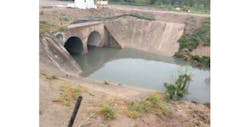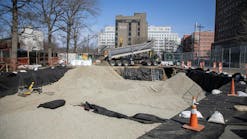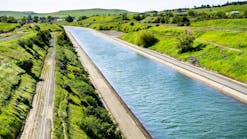In the rapidly growing border town of McAllen, Texas, dealing with storm water runoff is a challenge. The town’s population has nearly tripled during the past two decades and modifying the storm water infrastructure to keep up with the growth proved difficult. In an area where the weather rapidly fluctuates, ensuring storm water infrastructure can handle large amounts of water is paramount.
The Rado Storm Drain, located less than one mile from the Rio Grande, consists of two side-by-side 120-in. corrugated metal pipes (CMP), each extending more than 2000 linear ft. Since their installation more than a decade ago, the pipes have presented some issues, despite repairs in various sections with non-structural shot-crete and bitumen coating. As the problems persisted, large-scale separation of the joints and infiltration continued to be major concerns.
The local municipalities had previously been unsuccessful with non-structural repairs on this particular application. To find an effective solution to their mounting storm drain infrastructure concerns, they investigated several repair options, including cured-in-place pipe (CIPP), slip-lining and GeoSpray geopolymer mortar.
Solution
Both the CIPP and slip-lining solutions were significantly more costly than geopolymer mortar and would have brought on additional complications due to the large diameter of the pipe. The community elected to use a GeoSpray geopolymer mortar solution for the structural rehabilitation.
Because the Rado Storm Drain consisted of two side-by-side pipe sections, the community was able to repair one at a time, utilizing the other to divert flow. Stopping water infiltration was the primary challenge of the project and required meticulous preparation. Each pipe section was cleaned and inspected for joint failure, cracking and infiltration. These issues were addressed with hand repair to ensure the infiltration of water was stopped and to create a continuous surface for the application.
Once these issues were tackled, 150- to 300-ft sections were sprayed with 1-½ in. of GeoSpray geopolymer mortar. The ability to apply a 1-½-in.-thick layer in a single spray pass saved both time and cost for the asset owner. During most days of operation, the contractor was able to apply between 20,000 and 40,000 lb of GeoSpray geopolymer mortar in a single run within the pipe, creating a truly monolithic structure.
Results
The use of the GeoSpray system to create a new pipe within the existing CMP structure was completed on time and under budget. GeoSpray geopolymer mortar allowed for a significant cost savings when compared to other traditional trenchless repair techniques, such as CIPP and slip-lining. The new pipe is ready to handle the unpredictable storms of southern Texas for years to come.






